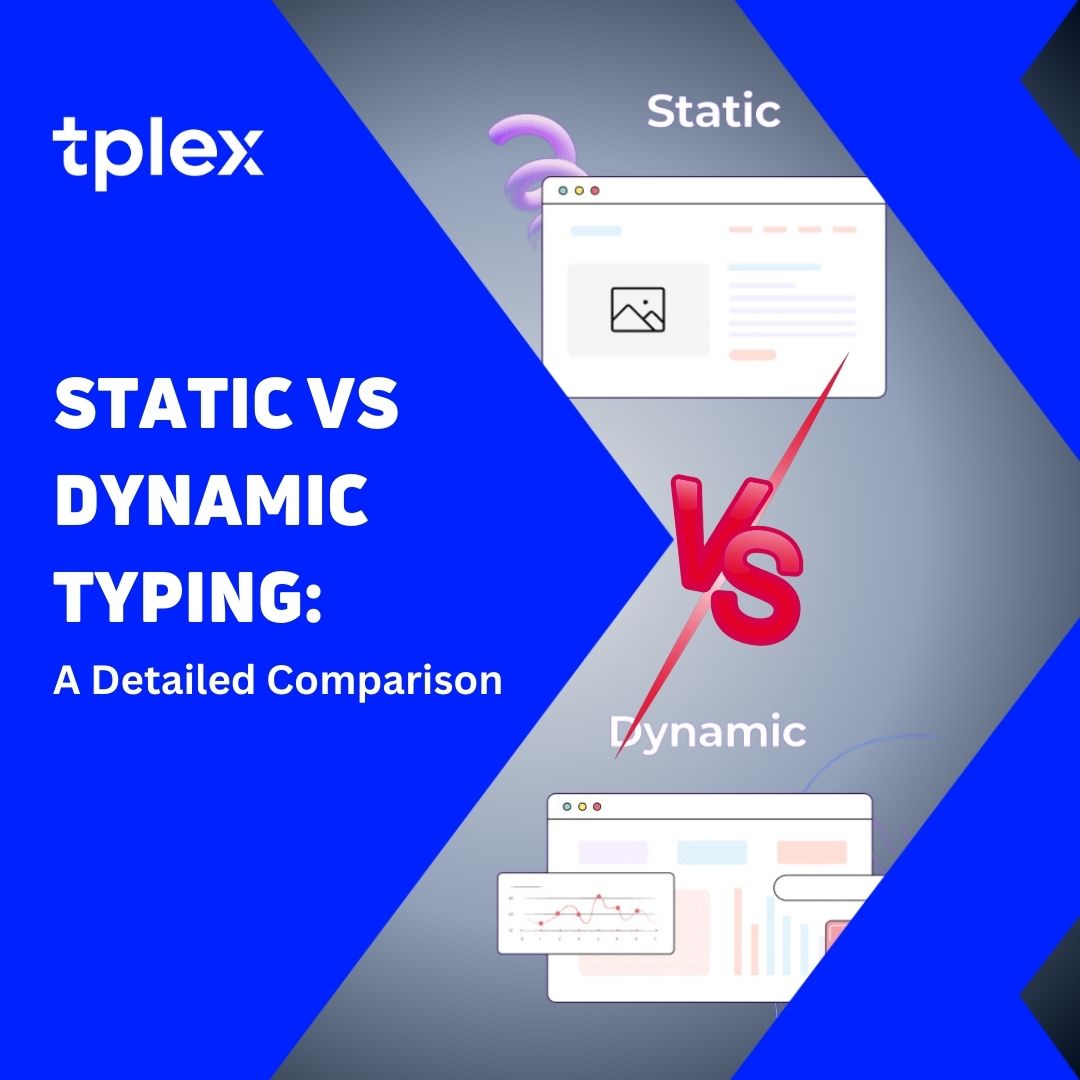Static vs Dynamic Typing: A Detailed Comparison

When discussing the key elements of programming languages, one of the topics that tends to spark significant discussions is static vs dynamic typing. It is not just an abstract debate, but one that comes with actual consequences, particularly when designing a software’s UI for usage, alterations, and possible expansion.
Static vs dynamic typing are essential parts of any programming language. Learn all about these languages in this blog!
The Basics: What is Static Typing?
Static typing is a feature of some programming languages, suggesting that the type of variable is first declared at compile time. This implies that the kind of variable to be used must be determined before being used. Having defined a variable, it can only contain another variable of a particular type if it undergoes type conversion.
Types of Static Typing
Statically typed languages are programming languages in which the data type of a specific variable is resolved in advance at the time of compiling that specific program. Although it is not a complete list of statically typed languages, here are some of the languages:
- Java: Java is another widely used programming language that is, however, statically typed and commonly employed in several industries, primarily in large-scale enterprises. Before using a variable in Java, you have to state the type it will contain. For example, if one wishes to store a number, he/she has to inform the Java compiler that the variable that will be used will contain an integer. The same concept applies to text and indicates to R that the variable will contain a string you use.
- C++: C++ is another statically typed language that has found significant usage, especially in operating systems and gaming applications. Precisely as in the Java language, one has to determine the type of variable beforehand. For instance, when you want to store a number or text, you are required to define the type of the values you are storing: integer or string.
- C#: It is a programming language created by Microsoft Corporation and mainly used to create Windows applications and games using the Unity engine. As in many other languages of its kind, in C#, you define the type of each variable from the beginning. This is why you must state what type of data the variable will contain, for example, number text or any other type of data.
Statically typed languages assist in discovering problems at the compilation stage, thus increasing the program’s stability and decreasing the possibility of encountering and correcting the error.
However, they also impose the need to write additional code to declare the typing more explicitly. While some premature constraints may hinder the team’s creativity, this tradeoff is usually beneficial for bigger and more complex projects to avoid making an error that would cost significant time and resources.
Related Article: Top 10 Programming Languages for Artificial Intelligence
The Basics: What is Dynamic Typing?
Dynamic typing is the type of polymorphism where no declaration of a variable’s type is principled, and usually, the variable is assigned when it is being used. This makes it possible for the variable type to be called when the program is running as opposed to when it is being compiled. In the variable name with which you want to work, you can assign the value of any type and change the type of the variable at any moment. For instance, one time, a variable that stores a number can be assigned a text value the other time.
Types of Dynamic Typing
When understanding static vs dynamic typing, it is important to understand the different types of dynamic typing. Some popular languages that fall under dynamically typed languages are as follows:
- Python: For instance, Python is currently one of the most widespread dynamically typed programming languages. Unlike languages, you don’t have to indicate the type of variable you intend to use for storage. For example, you can first assign the variable with a number and later reassign it with the string. This characteristic of Python makes it valuable and perfect for working on projects that need a quick solution.
- JavaScript: JavaScript is another powerful example of a dynamically typed language that failed to garner much popularity, specifically in the development of web applications. JavaScript, like Python, allows the redeclaration of the variable and provides the facility to assign any type of value to the variable. Some Common Lisp examples illustrate this: You can begin with a number, then transform the same variable and turn it into text. He declares that JavaScript has some kind of flexibility, but these very activities require some extreme caution of the programmer to avoid some type-related mistakes.
Differences between Static vs Dynamic Typing
- The only significant difference between static vs dynamic typing is the time in the development phase at which the checks are performed. Static typing, on the other hand, involves type checking at compile time and thus refers to languages that require the specification of data types.
- Internally, type checking operates in strongly typed languages, and externally and actually, in dynamically typed languages, where type check occurs as the program is being executed. It is for these reasons that several other distinctions are guaranteed by this defining key difference.
- Static typing offers type safety over dynamic typing because errors are detected before the programs are run. This implies that during the program’s execution, there are fewer chances of making wrong entries or programming. Instead, dynamic typing is more vulnerable to typographical errors because errors are detected only during program execution.
- One differs from the other in terms of the outcomes delivered. Static typing typically has superior performance since the compiler has the benefit of knowing the types and can thus make these kinds of optimizations. Runtime checking is done in dynamic typing, and this might result in slow code execution since more time will be spent checking the type of the operand.
- The other relative difference is versatility, where static typing is above dynamic typing. Static typing is less flexible here because types must be declared, and methods cannot change them but with an explicit type conversion. Flexibility is more so with dynamic typing, as variables have dynamic and concrete types without having to be explicitly stated.
- In terms of comprehensibility and sustainability, static typing promotes factors such as easily understandable type information in code. Dynamic typing is optimal for producing short-scale code and makes the code difficult to update and read.
Advantages of Static vs Dynamic Typing
Static typing possesses certain advantages. It makes for early identification of errors since they are detected when the compiler is being run instead of the program runtime. Compilers can also generate more optimized code as they can determine how to best allocate space for values of various types. Annotations made in strong, statically typed languages are mainly used in documentation to enhance understanding of the coded sequences. Some operations, like renaming a variable to something shorter or more sensible, are safer and more reliable in statically typed languages.
As for the advantages of dynamic typing there are also some. This one is easier to use because when the code is written, there is no need to declare the types of arguments the function takes and the data it returns; the second, you write less boilerplate code. It permits the creation of working prototypes quickly; this makes it easier to write and edit code, making it a perfect tool for working in small cycles.
Dynamic typing is another feature that brings flexibility. It liberates the use of more general functions and methods, resulting in a more liberal code. While some people argue that verbose code in dynamically typed languages is excessive and requires more writing, others argue that it can be excellent for increasing the speed of development.
Disadvantages of Static vs Dynamic Typing
However, the typing systems mentioned below also have some disadvantages. Static typing involves specifying the types of the variables in advance, which involves writing more code, a process that can be time-consuming. It is less flexible; polymorphism becomes a constraint as opposed to a feature because of extensive type specifications that must be made when writing generic functions. Applying compilation can take a longer time than applying interpretation due to type checking and optimization.
Dynamic typing does have its own complexities. It is more prone to runtime errors because it can implement the operation at a much later stage. Static type checking is useful as it helps to reduce development time and eliminate some errors, but with dynamic type checking, the gain in development time is compensated by the performance overhead that it introduces.
Evolution 3 might seem obvious, but it is worth pointing out that dynamically typed languages are notorious for the removal of the common and effective use of type declarations, which enhance the readability and maintainability of the code. It is also important to note that some enhancements may be functional only with statically typed programming languages.
By discriminating between static and dynamic typing, programmers can select the most suitable course for themselves and their project by deciding whether the drawback of static typing is more important than the benefit of dynamic typing, and vice versa.
Summing It Up
In this article, we have seen that static vs dynamic typing languages are two ideas that can be discussed and are not judged as either good or bad. They have advantages and disadvantages and should be selected depending on the needs of a specific project, the requirements of a particular team, and the particularity of the project.
Thus, the debate on static vs dynamic programming continues. However, situations, when development processes are based on JavaScript, are definitely not a thing of the past, as examples of new approaches like TypeScript or Kotlin show that developers have more options than ever to get the best of both worlds.



